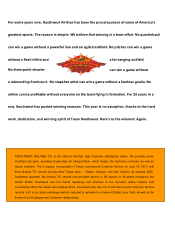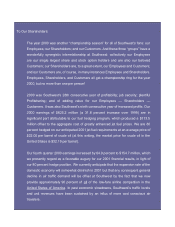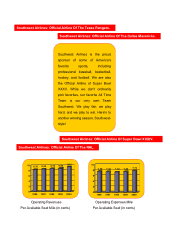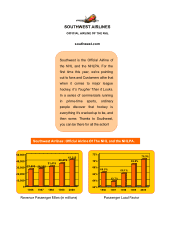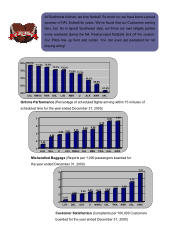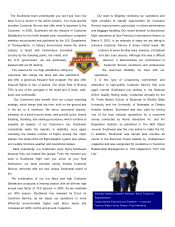Southwest Airlines 2000 Annual Report Download - page 13
Download and view the complete annual report
Please find page 13 of the 2000 Southwest Airlines annual report below. You can navigate through the pages in the report by either clicking on the pages listed below, or by using the keyword search tool below to find specific information within the annual report.
Simplicity is a basic philosophy at Southwest.
Consequently, Southwest flies only one aircraft type,
the Boeing 737, which is perfectly suited for our
shorthaul market needs. We’ve grown from three
aircraft in 1971 to 344 aircraft at the end of 2000, the
largest all-Boeing 737 fleet in the world. Our unique
commitment to one aircraft type significantly
simplifies our operations in terms of
maintenance, scheduling, staffing, and
training. As a consequence, all of our
players, regardless of their positions, can
devote their time and energy completely
to mastering just one aircraft type. This
“keep it simple” approach contributes to our superb 29-
year safety record as well as our low cost structure.
As the launch Customer for Boeing on the -300, -
500, and, most recently, -700 models, we achieve
attractive aircraft acquisition costs. This, coupled with
our young, modern, well-maintained fleet, allows us to
produce low overall costs of ownership.
The Boeing 737 is well-suited for operation in
Southwest’s shorthaul market niche, yet it is flexible
enough to meet our needs on longhaul flights.
Although we have added more longhaul flights to our
route system over the past several years, the majority
of our daily departures is shorthaul. Longhaul flights
are offered in low frequency, achieve high load factors
with our classic low fares, and offer a nice complement
to our core high-frequency, shorthaul business-
oriented route structure. After all, business Customers
take vacations, too!
Southwest was built to meet the needs of the
shorthaul, local, point-to-point Customer, and this
remains the primary team focus. As a result of this
focus, approximately 70 to 80 percent of our
passengers fly nonstop, in sharp contrast to a hub-
and-spoke carrier, which concentrates on connecting
traffic.
From an operational perspective, we make it simple
for our Customers to book a Southwest flight. They can
either call one of our helpful Reservation Agents at 1-
800-I-FLY-SWA or log on to our “Customer friendly” web
site at southwest.com to enjoy our low fares, simple fare
structure, and high-quality Customer Service. Our
distribution system is easy and convenient for
Customers and very cost-effective and efficient for
Southwest.
Southwest also utilizes simple, quick, and
efficient boarding procedures. Reservations
can be made for a flight, but seating is open.
Since we treat all of our seats in our single-class
cabin configuration as “first class,” assigned seating
isn’t necessary. On short flights, meals simply are not
necessary. Instead, we offer friendly, fast, inflight
beverage service, perfectly suited for our market niche.
Our Southwest team realizes taking a trip can be
stressful. That’s why we do our best to minimize the
“hassles” associated with flying, and why we favor
conveniently located satellite or downtown airports such as
Albany, Baltimore, Burbank, Dallas Love Field, Ft.
Lauderdale/Hollywood, Houston Hobby, Long Island/Islip,
and Providence. We also avoid costly and complicated
interlining arrangements with other carriers.
While our approach may be simple, our Customer
Satisfaction consistently ranks the best in the industry
because we deliver what the Customer wants in shorthaul
markets.
Dan Mega, Maintenance, Field Technician Manager
Jesus Melian, First Officer
Jim Wimberly, Executive Vice President — Chief Operations Officer


